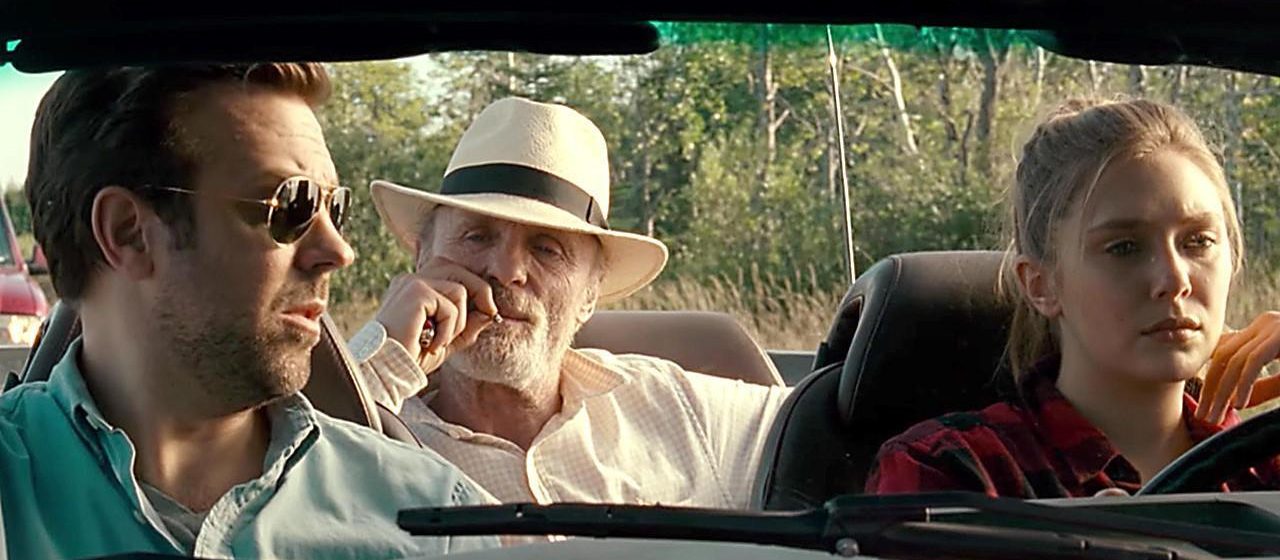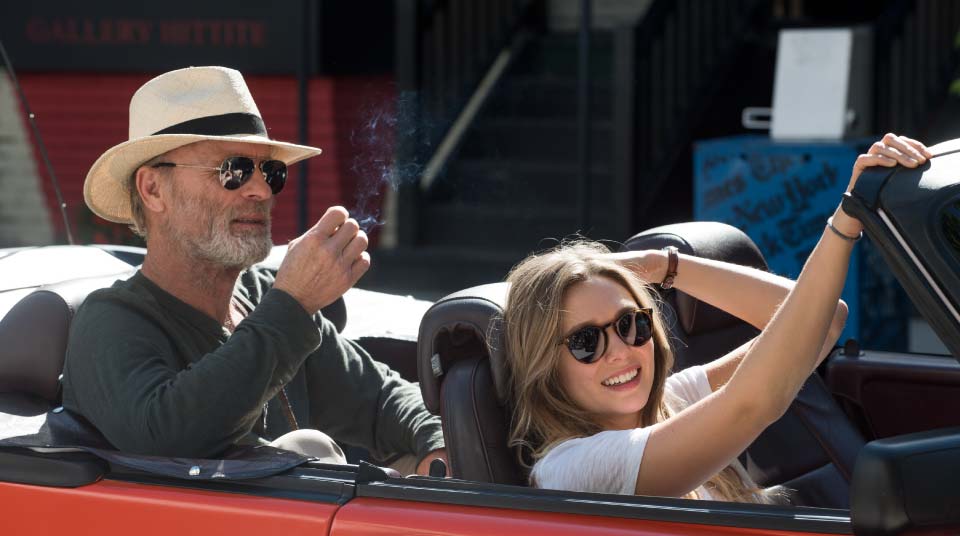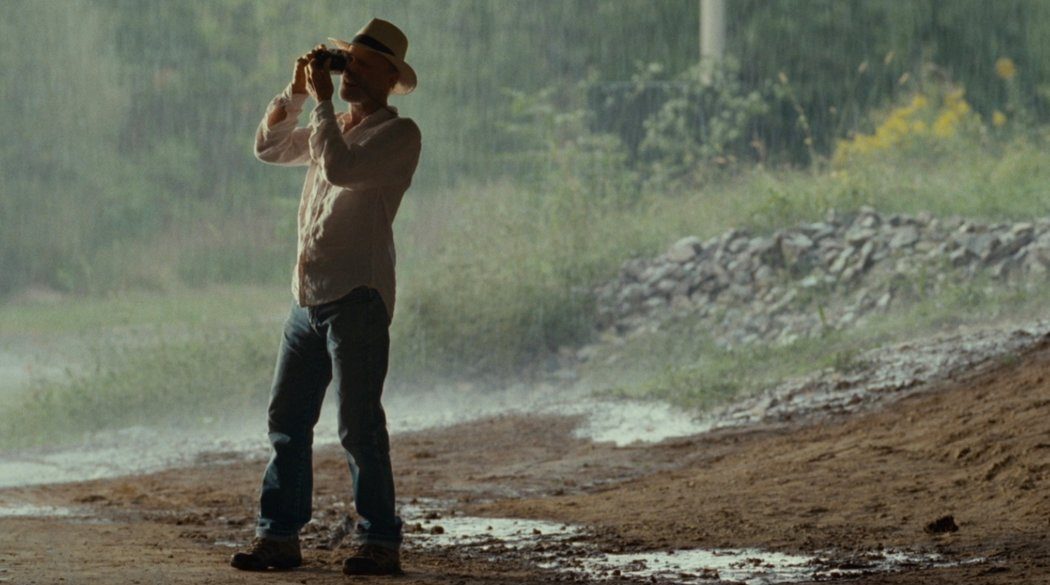

“We’re all so frightened by time, the way it moves on and the way things disappear. That’s why we’re photographers. We’re preservationists by nature. We take pictures to stop time, to commit moments to eternity. Human nature made tangible.”
The father-son road trip of Kodachrome is as predictable as they come. Early in the film we learn that legendary photographer Benjamin Asher Ryder (Ed Harris) is dying. His final wish is for his estranged son Matt (Jason Sudeikis) to drive him all the way from New Jersey to Kansas to develop a few rolls of “early work” before that’s no longer a possibility. It’s very easy to guess what we’ll find in those lasts rolls of Kodachrome long before we see them, and it’s similarly trivial to spot the standard story beats coming from a mile away, whether that’s the reconciliatory moments between father and son or the love interest between Matt and Ben’s nurse, Zooey (Elizabeth Olsen). Although its script leaves much to be desired, the subtly crafty direction from Mark Raso, the stellar acting by the three leads, and the appeal for authenticity at its heart allow the film to connect despite its flaws.
In addition to Ben’s aggressive cancer, the trio are racing against a clock set by Kodak when they announced they would cease producing the chemicals required to process Kodachrome.1 Ben’s made arrangements with Dwayne Steinle, the owner of the last Kodak-certified processing facility in the world, to have his four rolls developed on “the last day.” Of course, Ben is a strictly analog kind of guy. He doesn’t trust the “electronic dust” of digital files, that’s why he shoots exclusively on Kodachrome. Likewise, he doesn’t trust the FedEx tracking system or GPS. So instead of mailing his rolls, he’s traveling cross-country with his nurse and a son who hates him with only a map for guidance. Along the way, stops are made to visit Ben’s brother Dean (Bruce Greenwood), who hates him; and at a rock concert where Matt, a talent evaluator for a small record label, is scheduled to make a pitch to an up-and-coming band.

The film is most effective when the cast are given some breathing room which allows for moments of humor, cruelty, and tenderness, sometimes overlapping. Unfairly pigeonholed due to his time spent on Saturday Night Live prior to taking on film roles, Sudeikis is given a chance to spread his dramatic wings and does an admirable job. His comedic timing and delivery are expectedly on point—his cynical sarcasm is superb—but it’s the vulnerable moments that he handles with unforeseen aplomb. Ed Harris is terrific as the cantankerous old man who knows he’s a surly scoundrel. His balance between unruliness and obscured humanity is first-rate. Ben’s tense exchanges with Matt vary between the dramatic and comedic, until towards the end, when Ben realizes he’s nearing his final breath. His guard comes down and he bares his soul to his son who has hated him for his entire adult life. It’s a clichéd moment, but that doesn’t mean it isn’t effective. Olsen, unfortunately, is not given enough to work with. Her character serves the function of bridging the emotional distance between the father and son in the early-going, then shifts to an inevitable romance with Matt later on, although this is a severely underbaked sub-plot. Her best scene is at the bar after Matt loses his job at the record label the same night she is “fired” by Ben. Following up on an earlier scene in which Matt tried to guess her musical tastes, the two get drunk and begin singing along to Live’s “Lightning Crashes”.
A love of music is one of the only things that Matt believes he inherited from his father, and the soundtrack is selected with precision. Although Paul Simon’s “Kodachrome” did not make the cut (or perhaps, the budget), Galaxie 500, Indians, Pearl Jam, and Graham Nash are all featured. However, I found that Agatha Kaspar’s score, while not objectionable per se, was employed too often to sap things up unnecessarily in some of those glossy, manufactured emotional moments that never feel authentic.

In addition to its central drama between father and son, Kodachrome is also lamenting the fading way of life before the onset of the digital era. In an age when everyone has a high quality digital camera in their pocket, we take pictures of everything—our friends, our food, our pets, ourselves—and then promptly forget about them as they languish in the digital ether. When we need more storage space, we delete the inferior shots and replace them with more drivel. This tragedy of replacing lasting artifacts with large quantities of low-quality digital data is what Kodachrome is really about. And that can be extended to include the transition from vinyl records to mp3s, physical books to touchscreens, from 35mm film to digital at the cinema. Raso apparently takes his own message to heart and the film ends with a note that the entire movie had been shot on 35mm—of course, then it was digitized and sent to Netflix so that people could stream it into their homes, but let’s pretend to ignore that. At least it was shot on celluloid.
Kodachrome is worth seeing for its performances and its lament for a bygone era. Although it unfolds exactly as you’d expect, it does so with skill and sincerity. I don’t care that it is derivative of Nebraska, the commitment to its central message, the undeniable passion, and the lead performances are all commendable.
1. The film was inspired by a 2010 New York Times article detailing the mass pilgrimage of Kodachrome fans to Dwayne’s Photo in Parsons, Kansas, where the early color film was officially retired. Dwayne Steinle was a holdout—his store was the last remaining Kodak-certified processor in the world. Although many had shifted to digital photography, plenty of hobbyists still preferred the quality of Kodachrome. When Kodak announced that they would cease production of the chemicals required for processing, more than a few enthusiasts came out of the woodwork, inundating Dwayne’s with thousands of rolls to be developed before the deadline.
Sources:
Sulzberger, A.G. “For Kodachrome Fans, Road Ends at Photo Lab in Kansas”. The New York Times 29 December 2010.